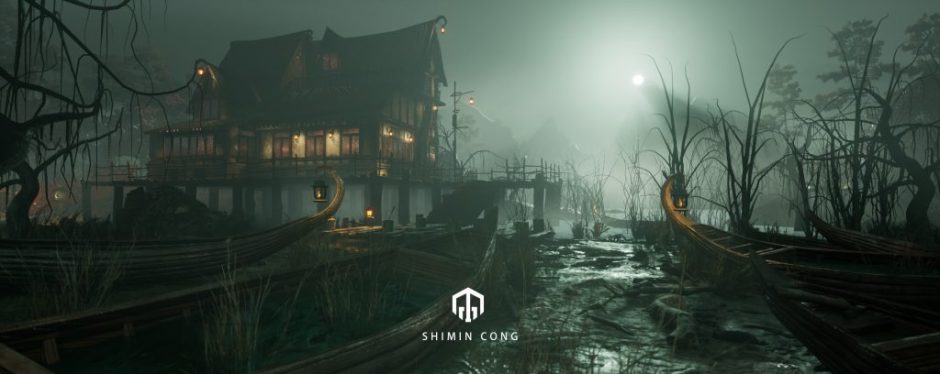FMP_Immersive game
GAME OVERVIEW
This project is a demo of a horror puzzle game with a play time of 5-10 minutes. Players will listen to a memory of the protagonist in a short game time. The focus of game design is on immersive experience. This includes the stylized model of the game scene, lighting, layout and UI…
WHY CREATE THIS GAME?
In addition to the innovation in gameplay, many gamers are beginning to pay more and more attention to the visual effects of the game。
In the second and third term game project and the production of Cthulhu CG animation, I have mastered the Unreal material system, lighting system, VFX system, sequence frame system and terrain system. But to become a game technical artist, I also need to start a game project to consolidate the skills learned while mastering the ability to write blueprint logic.
In addition, besides technical art, my second job choice is game terrain editor. Therefore, the game project is still based on the scene experience. Taking into account the limitation of playable time, in order to make players have a good sense of game immersion, thriller is a good direction.
Finally, I also hope to consolidate the knowledge of story arc through this project, and enhance my storytelling ability.
RESEARCH AREAS
- Game level design
- story arc
- Interaction design_ flow experience and unconscious design
- Unreal
- Blueprint
- VFX system
- Material system
- Lighting system
- terrain system
- Engine logic
REFERENCES
Chen Xinghan believes that games should not be regarded as products that promote violence. The flow experience of games should be pleasant and satisfying. Through the research of flow experience, he has produced many well-known art games, such as Journey “, “flower”, etc.
As for the game’s biggest reference, Edith Finch is the game. One of its major features is that the subtitles are cleverly integrated into the scene. And this form of storytelling is also worthy of reference.
In contrast, the interactive design of plants and fish in ZBZU’s game is worth studying. With such a large scene, it is obvious that the movements of these fish are not done through traditional rig and animation, but through the world scene position offset and mask to control.
AIM
- Perceived immersion
Complete perceptual experience- more perceptual experience the game can provide
Strong emotional response-the game can arouse strong emotional ups and downs in the player
Emotional interaction and resonance-the game experience can arouse the player’s emotional resonance
That is to have a perfect game scene, scene layout and lighting - Cognitive immersion
Cognitive immersion includes three aspects. Keep cognition as simple as possible, use visual levels to sort out information, and use narrative design methods to make players more immersed. That is to have a complete and ups and downs story line. - Operational immersion
At the operational level, if you want players to form a sense of immersion, you must have a reasonable UI layout and icon design. - Improve the skills required by game technical artists.
RESOURCES TO USE
- MAYA _modeling character rigging and simple animating
- RizomUV_ Onwrapping
- Mari_character color map and displacement map
- Mixer_ texturing for landscape and wall
- Substance painter and designer_ texturing for object
- Zbrush_Sculpturing
- Houdini_ landscape system
- Unreal4
Thesis Proposal
My thesis is related to the FMP project. They are all aimed at the immersive experience of games. And thesis is to analyze immersive games in the field of flow experience and unconscious design. FMP is a practical study of the thesis.
Abstract
Flow experience, unconscious design and immersion are the words we often mention in game development. An immersive game is more than just a beautiful game scene. It also needs to cooperate with the gameplay mechanism, UI, story and other factors. Therefore, this article will specifically introduce the concepts of flow experience, unconscious design and immersion, as well as the previous relationship between the three.
Flow experience
The creator of flow theory is Mihari, a famous American psychologist. He initially discovered this shared experience-flow experience through a large number of interviews by studying the source of people’s happiness. There are eight characteristic elements that constitute the flow experience, including: 1 clear goal, 2 timely feedback, 3 challenge and ability balance, 4 sense of control, 5 elimination of distracting thoughts, 6 concentration of current tasks, 7 loss of self-awareness, 8 sense of time distort.
Analyze the practical application of the flow experience of “flower” and “ABZU”. (Gameplay mechanism and game scene construction)
Unconscious design
Unconscious design is the designer’s unconscious operation through conscious design. This article will specifically describe how the game UI design enhances immersion from the unconscious aspect.
Reference
https://en.wikipedia.org/wiki/Flow_(psychology)
https://www.frontiersin.org/articles/10.3389/fpsyg.2020.00158/full
Hoshi, K. and Waterworth, J., 2020. Unconscious Interaction and Design. In Primitive Interaction Design (pp. 75-86). Springer, Cham.

